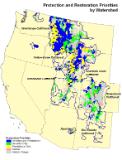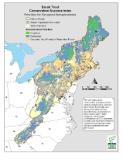Conservation Success Index
Conservation Success Index
Now the CSI can be used to investigate crimes against nature.
Trout Unlimited has developed its own Conservation Success Index, or CSI, to compare the status of native trout and salmon throughout the United States and to develop priorities for protecting and restoring aquatic resources. The CSI provides a framework to examine the range-wide condition, habitat integrity, population integrity, and future risk of native coldwater fishes using data provided by state, federal, tribal, and non-governmental organizations.
Many of our streams and rivers have been severely degraded by dams, water diversions, other habitat alterations, and pollution. Aquatic habitats also frequently have been invaded by non-native species, including not only exotic fishes but also invasive plants, snails and other non-native invertebrates. Ironically, brook trout, which TU is striving to restore within their native range in the East, have been inappropriately introduced into streams in the West where they impact native cutthroat trout.
Overall, the impact to aquatic communities has been so extreme that more than one in three native fishes in the United States is now at risk of extinction. Extinction rates are five times higher for freshwater species such as fishes and mussels than for birds, mammals, or other terrestrial species.
As a group, native trout are at high risk despite their substantial economic, recreational, and ecological values. Most native trout species are listed as threatened or endangered under the Endangered Species Act, are considered to be candidates for such listing, or have recently been petitioned for listing.
Native trout are good indicators of the health of aquatic communities, especially our nation’s streams and rivers, for the following reasons:
- Native trout are sensitive to physical alteration as well as chemical and biological pollution of their habitats. If native trout occur in large numbers, their habitat is most likely to be high quality and largely free of non-native species.
- Native trout are broadly distributed and thus encompass a large number of river basins throughout the western United States.
- Native trout are among our best-monitored and well-known aquatic species. Fisheries agencies tend to have more and higher quality data for species like trout and salmon than for other fishes. Thus their status and trends are more readily determined.
The Conservation Success Index map will be periodically updated to include more native species, such as Lahontan cutthroat trout, Gila trout, redband trout, and golden trout. Look for more information about the CSI and expanded future species coverage under the “Science” banner at Trout Unlimited.
Priority Watersheds in the West
The western United States map identifies watersheds containing high priority native trout populations. Two criteria—genetic purity and population persistence—are used to determine priority status.
To meet genetic purity criteria, populations must be within their native range and be 90% or more genetically pure. Because hybridization with non-native trout is a major threat to many species, genetic purity is an important indicator for population integrity and the presence of non-native species.
Population persistence is another critical factor for native coldwater fishes. Populations must have sufficient habitat of suitable quality to support an “effective population” of at least 500 adults to meet persistence criteria. Because the effective population size assumes an equal sex ratio and equal spawning contributions per adult, it often requires a total adult population of 1,000 to 2,000 fish to equate to an effective population of 500.
The highest priorities for protection are those populations that meet both the genetic and persistence criteria, while populations that meet one but not both criteria are high priority for restoration. For example, if a population meets only the genetic purity threshold, then its habitat needs to be restored and/or expanded so that the population can support an effective population of at least 500 adults. On the other hand, if a population meets only the population persistence threshold, then non-native species control efforts are likely to be needed.
Priority Watersheds in the East
The map of the Eastern U.S. shows protection and restoration priorities for brook trout. These priorities are established at the subwatershed scale, which are smaller subsets of the watersheds identified for western trout.
The highest protection priorities are brook trout strongholds supported by habitats with high integrity. Habitats for restoration priority are identified based on population and/or habitat declines.
Unlike their western counterparts, eastern brook trout are not threatened by hybridization with non-native trout. In the East, the genetic concerns are more related with interbasin transfers of brook trout, which confounds the desire to maintain genetic purity and adaptation of the local genome. In terms of habitat degradation, eastern stream systems are threatened primarily by deforestation, overgrazing by livestock, pollution, conversion of land to agriculture, and expanding urban areas.
Go Straight to Your State
Learn about conservation and open space in your state.




